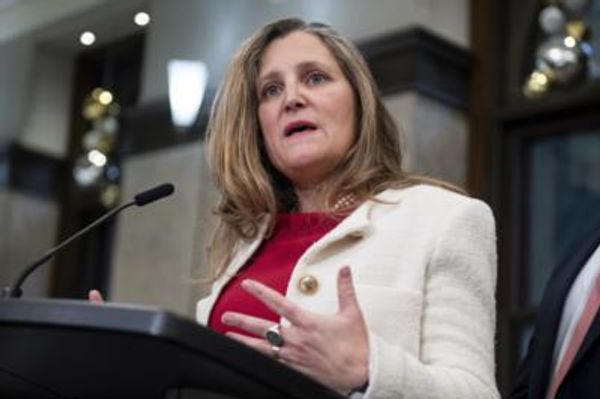
"At least $2 trillion" was Elon Musk's casual preelection response when asked how much a new Donald Trump administration could cut from the federal government. As a goal for the new administration, $2 trillion in cuts is both perfectly reasonable and politically impossible. The federal government, now burning $6.8 trillion annually, ran on $4.4 trillion just five years ago—hardly a time of fiscal restraint. But any ambition to curb government spending will have to contend with a political reality that isn't exactly primed for austerity—especially under a second Trump administration, where a potent combination of executive power, cronyism, and party infighting looks likely to dominate.
Musk, along with one-time presidential aspirant Vivek Ramaswamy, has been tapped to head a new Department of Government Efficiency (DOGE), which will have a mandate to cut, but unclear status and authority.
Meanwhile, Trump returns to the White House with an agenda fueled by old grievances and new entitlement. Throughout his first term, Trump demonstrated an appetite for executive authority, bypassing Congress to impose tariffs, constrain immigration, declare emergencies, and unilaterally reshape policy. Those tendencies are likely to take the lead in a second Trump administration, as he retakes the Oval Office with a fresh list of targets he perceives as enemies within the federal establishment.
While a Muskian vision of downsizing may align, on the surface, with Trump's antibureaucratic rhetoric, Trump's second term seems more likely to favor selective budget adjustments aimed at punishing certain agencies rather than achieving broad fiscal discipline.
With a narrow Republican majority in the House, the prospects for reining in Trump's more expensive ambitions are complicated. A slim majority means House Republicans will be juggling competing priorities within their own party, including demands from the tiny cadre of remaining fiscal hawks and Trump-aligned members with an appetite for selective spending. Any genuine attempt at oversight or restraint is likely to be hampered by these internal divisions and the tendency to avoid cuts in areas that directly benefit Republican constituencies, such as defense. Rather than delivering meaningful cuts, a narrowly Republican House is more likely to rubber-stamp Trump's ever-changing priorities, without regard for the price tag.
To make a real dent in spending Musk would have to start with one of the clearest targets: federal grants to states. These grants, which give states incentives to follow federal policy on everything from education to transportation, amounted to $721 billion in 2019 and have surged since the COVID-19 era. Cutting back on federal support to states could not only ease budget pressures but would also reinforce federalism by allowing states more freedom to allocate resources without chasing federal dollars.
But Trump's track record doesn't suggest he's keen to unwind these programs wholesale. While he may be willing to take on certain grants as symbolic gestures, a complete rethinking of the federal-state relationship would likely clash with his penchant for rewarding allies and punishing enemies. Musk's approach would need to avoid this selective targeting and advocate for a broader rollback of federal support to states, shifting responsibility back to local governments without using it as a political weapon.
Next on the chopping block could be federal subsidies for private businesses. From agriculture subsidies to tax incentives for manufacturers, corporate welfare has become a fixture of U.S. budget policy, allowing certain companies to benefit based on political clout rather than market success. Ideally, Musk's proposed cuts would end business subsidies, forcing them to compete based on merit rather than handouts. Musk's Tesla is a beneficiary of such largesse, of course, including loans from the Department of Energy, tax credits for electric vehicles under the Inflation Reduction Act, and emissions credits. And his SpaceX benefits from government contracts with NASA, though these almost certainly save the space agency money (and heartache) compared to other possible vendors.
Trump, alas, seems more interested in using subsidies as leverage, favoring companies or industries that align with his political goals or constituencies. A genuine push to eliminate corporate welfare would require a commitment to impartiality, something that doesn't align neatly with Trump's "America First" brand of economic interventionism. To make meaningful cuts stick, the administration would need to adopt a consistent policy of reducing corporate welfare regardless of industry or political affiliation—a commitment that may not sit well with Trump's instinct for rewarding loyalty.
One of the largest sources of government spending—and a tempting target for reform—is health care. Medicare, Medicaid, and federal support for private insurance cost hundreds of billions every year. The current system is littered with subsidies, tax incentives, and regulatory requirements that drive up costs while obscuring price transparency, leaving patients and providers without clear signals for cost control. If Musk is serious about cutbacks, addressing this spending would be crucial.
But Trump's first-term attempts at reining in health care costs fell short. His stance on health care has largely involved tweaking around the edges—repealing mandates, promoting price transparency—without fundamentally rethinking the government's role in subsidizing the industry. For Musk's plan to work, any cuts to health spending would need to be accompanied by structural reforms to enable a more market-driven system, something Trump has so far shown little interest in pursuing.
For Musk's vision to become reality, Trump would need to set aside his preference for expansive executive authority and targeted, cronyist spending. According to the Committee for a Responsible Federal Budget, Trump's proposed policies would add an estimated $7.7 trillion to the debt over the next decade. While some of Trump's ideas, like extending tax cuts, may spur economic growth, others, like tax credits for homebuyers or certain trade tariffs, represent the very type of special-interest giveaways that have to go.
All of this presumes that the Department of Government Efficiency attains a more solid form than a press release on Truth Social—and that the famously volatile Musk even makes it to Inauguration Day in Trump's good graces.
The post Promises To Cut $2 Trillion Clash with Trump's Expensive Plans appeared first on Reason.com.







